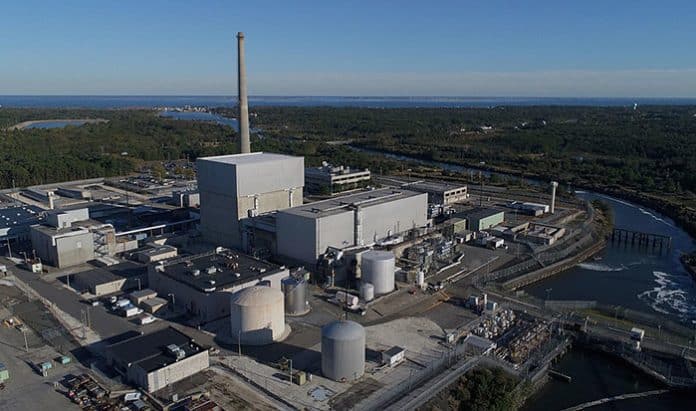
LACEY – The Nuclear Regulatory Commission (NRC) held another public hearing for residents of Lacey and surrounding municipalities on the shutdown of the nearby Oyster Creek Generating Station, owned by Exelon Generation.
The meeting was held at the Lacey Township Community Hall earlier this month where dozens of residents gathered to hear the officials’ reports for the decommissioning of the plant in more detail, as well as field questions from the public.
Overseeing Decommissioning
The presentations started with the NRC’s Bruce Watson, chief of the Reactor Decommissioning Branch. Watson discussed the overall process of overseeing decommissioning activities.
“It’s nothing new to us in how this work is done and we ensure it’s done safely,” said Watson, noting that the NRC has terminated licenses for over 72 complex material sites, power reactors, and research reactors.
Key regulations for the decommissioning process include: license termination, power reactor termination, independent spent fuel storage installation license (ISFSI), and inspection manual chapter 2561 dedicated to reactor decommissioning.
Included in the license termination is the process of fully, radiologically decontaminating the site and meeting the NRC’s criteria for unrestricted use.
“All of the sites that have been decommissioned in the US, including the power reactors, have been released for unrestricted use, meaning the owner can use the property for any purpose they want to after we terminate the license,” said Watson.
The inspection manual governs the reactor decommissioning process.
“One of the biggest things I hear is that when the plant shuts down, the NRC goes away,” said Watson. “That can’t be farther from the truth.”
The NRC will be using the inspection manual guidelines to continue expecting the plant until the license is terminated.

Storing Spent Fuel
Later on in the process, ISFSI deals with the storage of spent fuel, which for Oyster Creek, will be at the site for quite a while, according to Watson. Exelon plans to utilize dry cask storage using the SAFSTOR method for the spent fuel at Oyster Creek. The NRC stated that SAFSTOR allows for natural radioactive decay, produces less waste, exposes workers to less radiation, and is the most efficient option, allowing for dismantlement at any time.
Jeff Dostal, director of decommissioning, noted during his presentation that SAFSTOR allows all structures not supporting spent fuel storage to be “drained, de-energized, and retired in place, ready for removal.”
Dry cask storage involves removing the spent fuel pool and storing fuel on-site in dry cask storage systems. These are metal casks that the spent fuel gets stored in that then gets welded up and placed in concrete casks. NRC officials will come out and inspect these regularly.
The site will transform to include just an ISFSI only site where spent fuel is stored in a protected area and the rest of the site will be dormant.

Cost & Environmental Impact
A concern for some residents, such as Jeff Tittel, director of the NJ Sierra Club, was the security of the dry cask storage against situations where severe weather can affect them.
“The plant itself is falling apart and located on a site vulnerable to sea level rise,” said Tittel. “As long as the plant isn’t dismantled, the community remains at risk.”
Tittel used his time at the public hearing to push for a more accelerated decommissioning plan to reduce the risk to the community and reduce the overall cost to taxpayers. According to Tittel, Exelon’s 60-year timeline for decommissioning will cost taxpayers $1.4 billion. “Exelon wants to take longer to close the plant to make more money.”
NRC officials combatted concerns for the lengthy decommissioning process, stating that they must follow federal guidelines for the process and Exelon has up to 60 years to do so. Dostal’s presentation noted that the timeline could be shortened if new technologies for fuel storage are approved, but as of right now, the NRC plans to utilize the full time allotted for decommissioning.
“March of each year [the licensee] is required to send us [the NRC] a status on the decommissioning funds, so every year they are reporting to us what money is left or how much has been grown,” said Watson. The NRC verifies that amount each year. Watson also said that the PSDAR calculates the cost of decommissioning to be around $984 million.
Dostal’s presentation focused mainly on the PSDAR (Post Shutdown Decommissioning Report) which includes a description of decommissioning activities planned for the plant, a “high-level schedule” of decommissioning activities, cost estimates, and environmental impacts.

While NRC officials claimed that environmental safety was one of their priorities during decommissioning, some residents still harbored concerns, such as Katie Smith of the Pinelands Preservation Alliance.
“The generic environmental impact statement that the PSDAR relies on heavily is from 2002, so I’m wondering what the NRC thinks they’re missing,” she stated during the public hearing. Smith inquired to see if the NRC required a more updated environmental impact study off of which to base the PSDAR.
Watson noted that the NRC is in the process of updating the environmental impact study currently, however “pretty much the same methods you would use for decommissioning are still good from 20 years ago.”
He explained that the NRC is depending on the updated environmental impact statement and anything new that is discovered through the licensee’s review and the NRC’s own environmental review. All of these factors will be brought together with the PSDAR.
Overall Timeline
Dostal’s presentation on the PSDAR also incorporated a timeline for the decommissioning of Oyster Creek. Split up into a transition/planning stage and 5 individual phases, the Site Decommissioning Phased Approach takes us from January of 2018 to September of 2078, when the NRC hopes to see the license terminated.
- Transition Planning: This stage can be anywhere from 2 to 5 years and includes the formation of transition teams, development of staffing plans, development of strategic decisions, and the submission of official reports (like PSDAR). We are currently in this stage right now.
- Phase 1: This phase should take less than 30 days and hopes to take off in September of this year (the plant is slated to close Sept. 17, 2018). It includes offloading the core, implementing a permanently defueled e-plan, and implementing a certified fuel handler program.
These first two stages make up the Decommissioning Transition sector of the process, which will take us to October 2018. Next comes the SAFSTOR/DECON stage.
- Phase 2: Next is SAFSTOR/DECON, where all the fuel will be removed from the reactor. Phase 2 should take about 10 to 15 months and include: the movement of fuel to ISFSI strategic plan, retirement of structures not supporting spent fuel, and the implementation of defueled license and tech specs.
- Phase 3: This phase should take 3-5 years. Here we can expect to see spent fuel moved to ISFSI and completed preparations for collapsing the Site Protected Area. We should see all spent fuel in dry cask storage by November 2023, according to the timeline.
- Phase 4: This is the last stage of SAFSTRO/DECON, which can take anywhere from 10 to 49 years. Here will see a continuation of any decommissioning activities and the site will become ISFSI only. The NRC anticipates the fuel to be accepted by the Department of Energy by September 2034; however this is a rough estimate, officials stressed.
This last phase makes up the Site Restoration stage.
- Phase 5: This stage is for site restoration, which should take 2-4 years. Here the license is terminated and the site will be restored for any future use of the land. The NRC estimated by December of 2077, the site deconstruction will be complete. License termination is estimated for September 2078.
In related news, the NRC also recently approved Exelon’s request for changes to the post-shutdown emergency plans at Oyster Creek.

“The requested exemptions would allow Exelon to reduce emergency planning requirements and subsequently revise the OCNGS (Oyster Creek Nuclear Generating Station) Emergency Plan to reflect the permanently defueled condition of the station,” according to Exelon’s statement.
The changes to the emergency plans will take effect approximately one year after the plant shuts down on September 17, 2018.






